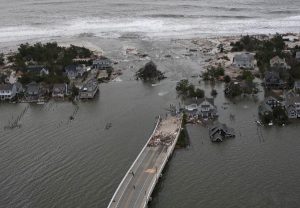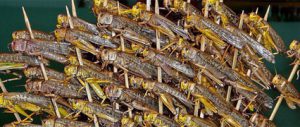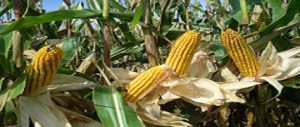The desert locust, the most notorious of about a dozen locust species for its ability to rapidly multiply and travel long distances, threatens an area of 32 million square kilometres, stretching across 50 countries from west Africa to India.
The fearsome insect has been farmers’ foe since the earliest days of agriculture.
When solitary, locusts are harmless. But when they congregate into groups they transform – in behaviour and even appearance – into killer vegetarians. In turn, swarms can be as large as several hundred square kilometres, of which a single square kilometre can comprise at least 40 million bugs, at times even double that.
In the immature adult phase, a locust can consume its own weight – about two grams – in vegetation per day, according to the UN’s Food and Agriculture Organization (FAO). One tonne of desert locusts ("a very small part of an average swarm", according to FAO’s website) could guzzle in a single day an amount of food equivalent to that consumed by 2,500 people. Locust plagues could therefore seriously imperil crop production, and in turn food security.
An ongoing desert locust upsurge, primarily along the Red Sea periphery, possibly acts as a reminder to a natural threat that is often overlooked, or even deemed a thing of the past.
Swarms of locusts spread from North Africa
Countries today are considerably better equipped to deal with the threat than they used to be. The second half of the twentieth century has seen a dramatic decline in frequency, duration and intensity of desert locust plagues, largely thanks to improved control and monitoring capacities in the affected countries.
"What we have done as a big improvement is to be able to monitor where the locust are and try to control them," says Pietro Ceccato, an environmental remote sensing expert with the International Research Institute for Climate and Society (IRI) at Columbia University. "Now we have that information – both from the control teams and from the satellite. We know where to target the control."
And yet, in anticipating future locust invasions, climate change appears to be one key unknown.
"This year is a bit unusual," says Keith Cressman, senior locust forecasting officer at FAO. Normally, he explains, after a good breeding season like this year’s, the locusts would move from Sudan to the interior of the Arabian Peninsula, across the Red Sea. This autumn, however, while some did reach Saudi Arabia, groups started migrating northwards to the interior of Sudan and further to Egypt, not before Sudanese authorities treated close to 270 square kilometres.
By late February, an outbreak looked imminent, as groups and swarms of a new locust generation started moving north. In early March, Egyptian news outlets and social media were teeming with reports and photos of the clouds of locust that had descended on Cairo.
"It is relatively rare that Desert Locust swarms reach Cairo," the website of FAO’s locust unit later reported. "This last occurred in November 2004, almost 50 years to the day after the previous occasion."
Within days, the swarms flying further east crossed the border into Israel, reaching the north west of the Negev desert. Three weeks later Jewish Israelis were celebrating Passover, commemorating the exodus of the Israelites from ancient Egypt, preceded by the Ten Plagues, the eight of which was the Plague of Locust.
According to FAO’s Locust Watch, April has seen a total of 220 square kilometres treated across five countries, down from 790 square kilometres in March.
In Israel, the ministry of agriculture reported in mid-May that damages to crops were "minimal," but concerns are of the next waves of locust coming in from Egypt’s Sinai peninsula as well as a new generation of the pest after extensive hatching has been detected.
"[Israeli] researchers had said that [the locusts] would not even be able to breed here due to weather conditions. And not only did they manage to breed, they have bred excellently and even settled. So, all projections were disproved," Dafna Yurista, the ministry’s spokesperson told chinadialogue. According to FAO, the last time Israel saw locust breeding and formation of hopper bands was in April 1961.
Nevertheless, and despite the ongoing outbreak, control operations across the region appear to have been effective. "So far, there hasn’t been any significant damage to crops," says FAO’s Cressman.
In Locust Watch’s latest update, from May 15, three countries were put on the second highest level of alert – Saudi Arabia, Israel and Sudan – and control teams have been operating to curb the infestations before the young hoppers become voracious adults by the end of the month.
Adult locust groups forming in these countries are expected to move back to the summer breeding areas in central Sudan. In addition, some locusts now in Saudi Arabia, the Locust Watch update stated, "could reach southwest Iran and continue moving eastwards."
"So far," Cressman says, "Sudan, Egypt, Saudi Arabia have been lucky. What we’re concerned about now is this coming month in Sudan, where we have a new generation of locust, and those immature adults more likely to stay in those cropping areas and eat whatever is green – basically, the seasonal crops."
The last time the region had faced a large-scale locust upsurge was in 2003-2005. Back then, swarms took off from Niger and moved up to north Africa, before heading east along the Mediterranean coast. Overall, 26 countries were affected, and nearly 130,000 square kilometres were treated.
Back then, Morocco alone treated 40,000 square kilometres over a two-year period, escaping the plague without any substantial damage, says FAO’s locust expert in the country Said Ghaout. This time, Morocco has seen a considerably smaller extent of infestation.
The impact of climate change
Yet both outbreaks have shown anomalous patterns, mostly owing to unusually favorable weather conditions at the locusts’ breeding areas. Ghaout does not rule out the possibility that climate change played a role, or that these outbreaks might be a sign of things to come. "This is a question everybody is asking," he says.
"It’s a real difficult topic," says Cressman about the possible effect of climate change on the desert locust. Generally, global meteorological models aren’t sufficiently reliable to make concrete predictions for the desert locust habitat range, and regional models for the relevant desert areas are not developed enough, he says.
Overall, forecasts for desert locust activity rely on four main factors: temperature, rainfall, vegetation and wind. "I took a look at all the data that we have so far, and looked at temperature – because that’s what everyone kind of agrees on, and we have the most data on – and it seems like if there’s an increase of temperature under climate change scenarios, the effect on desert locust is very minimal," says Cressman. In this case, "they might be able to get an extra generation of breeding in before the habitat becomes unfavorable."
It’s not all about temperature, however. To breed, desert locusts require moist soil and vegetation, so precipitation is key. But climate change models for the region contradict one another when it comes to rainfall, says Cressman.
For instance, in late April and early May, Saudi Arabia saw more rainfall than usual, which could in turn contribute to locusts moving further into the interior of the Arabian peninsula. "It happens that sometimes you have more rain, sometimes you have less rain," says IRI’s Ceccato, who monitors climatic and ecological conditions that affect desert locust activity. "But that happens. It’s variability. To relate that to climate change, it’s difficult."
China’s locust plagues
Several studies have tried to explore the possible impact of climate change on the abundance of another species, the Oriental migratory locust, in China. In 2011, researchers examined locust outbreaks recorded over a period of 1,910 years and meteorological data over the same time-span and concluded, that "there were more locusts under dry and cold conditions and when abundance was high in the preceding year or decade." Therefore, an increase in temperature or rainfall would actually mean fewer locust outbreaks.
A paper published four years earlier, based on a thousand years of records, has also suggested that warming could mean fewer locust plagues in China, since locust numbers were historically "highest during cold and wet periods".
Yet, a 2009 study using the same data came to different conclusions. Climate change, these authors said, could worsen locust outbreaks in China. Taking a more geographically nuanced approach, the researchers showed that, in north China, the most severe locust upsurges happened in warm and dry years. In south China, however, it was during warm and wet years.
Despite their contradictions, taken together these studies and others do offer some valuable insights, and not only for China. First, scientists seem to agree that rainfall could be affecting locust dynamics more than temperature. There also appears to be a consensus that climate change predictions for rainfall patterns are so far unsatisfactory.
And this is not the only missing variable. "The other aspect that nobody is really looking at yet is what’s going to happen to the wind under climate change," Cressman says, "because of course locusts migrate with the wind."
Even if projections are still inconclusive, history tells us that locusts have braved previous climatic changes, and humans need to prepare.
"Probably all countries need to review their preparedness in terms of some of these climate change scenarios, and maybe look at the worst case scenario," says FAO’s Cressman. In particular, that means preparing for longer locust seasons, he explains. "They’re going to have to make those plans a little more flexible."



